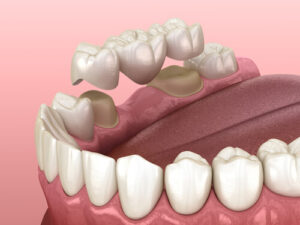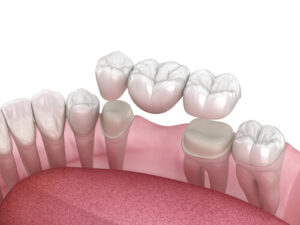Dental health is a vital aspect of overall well-being, and the role of dental prosthetics in restoring smiles and functionality is indispensable. This article delves into dental implant restorations, focusing on a key component: the pontic tooth. A pontic tooth is more than just a replacement; it’s a blend of art and science in dentistry, offering a solution for missing teeth that restores aesthetics and function. Join us as we explore pontic teeth’ intricacies, types, and benefits and understand how they can transform dental health and confidence.
Understanding the Pontic Tooth: An Overview
Understanding the pontic tooth is essential in modern dentistry, particularly for individuals with missing teeth. A pontic tooth plays a vital role in dental restorations, offering a functional and aesthetic solution for tooth and bone loss.
- Role in Dental Bridges: A pontic tooth is primarily used in dental bridges to replace one or more missing teeth. The artificial tooth fills the missing space, anchored between two dental crowns attached to the adjacent teeth (abutment teeth).
- Types of Materials Used: Pontics can be made from various materials, including porcelain, which is popular for its natural tooth-like appearance. The choice of material often depends on the location of the missing tooth, aesthetic considerations, and functional needs.
- Integration with Natural Teeth: For a dental bridge, the pontic tooth is crafted to blend seamlessly with the patient’s existing teeth in color, shape, and size. This ensures that the replacement tooth functions like a natural tooth and maintains the aesthetic integrity of the patient’s smile.
- Impact on Oral Health: Replacing a missing or extracted natural tooth with a pontic is crucial for maintaining oral health. It helps prevent tooth shifting, bite problems, and periodontal disease that can arise from the gap left by a missing tooth.
- Considerations for Placement: The pontic tooth’s placement is determined based on the location of the tooth loss, whether it’s an anterior tooth (front teeth) or a molar. The dentist customizes the pontic to ensure it fits comfortably and provides the right chewing surface.
The Role of Pontic Teeth in Dental Health and Prosthetics

The role of pontic teeth in dental health and prosthetics is multifaceted, bridging the gap between aesthetics and functionality. As a pivotal component in dental restorations, pontic teeth are crucial in maintaining oral health and enhancing the quality of life for individuals with missing teeth.
Benefits of Pontic Teeth in Dental Health and Prosthetics:
- Replacement for Missing Teeth: Pontic teeth are an effective solution to replace missing teeth, which is essential for preventing the shifting of adjacent teeth, maintaining proper bite alignment, and avoiding potential oral health issues.
- Prevention of Oral Health Complications: Pontic teeth help prevent periodontal disease and tooth decay in neighboring teeth by filling the gap left by a missing tooth. They also aid in distributing the forces in your bite properly to avoid issues with jaw joints and muscles.
- Aesthetic Restoration: Pontic teeth are designed to mimic the appearance of natural teeth, restoring the aesthetic aspect of a patient’s smile. They can be crafted from various materials, such as porcelain, to match the color and texture of existing teeth.
- Functional Restoration: Beyond aesthetics, pontic teeth restore the functionality of missing teeth. They enable proper chewing and speaking, often compromised when teeth are lost.
- Part of Dental Bridges: Typically, pontic teeth are used in dental bridges, where dental crowns anchor them on either side. This placement ensures the stability and durability of the prosthetic tooth.
- Customization Options: Pontic teeth are highly customizable, allowing dentists to tailor them to the specific needs and preferences of the patient, ensuring a comfortable fit and a natural look.
Types of Pontic Teeth: Materials and Design Considerations
The types of pontic teeth, distinguished by their materials and design considerations, are crucial elements in dental prosthetics. Each type of dental bridge is tailored to meet specific requirements of strength, aesthetics, and patient comfort, reflecting the advancements in dental technology and materials science.
Types of Pontic Teeth:
- Porcelain Pontics: Porcelain is a popular material for pontic teeth due to its ability to mimic the natural appearance of teeth. It’s often chosen for anterior teeth (front teeth), where aesthetics are a primary concern. Porcelain pontics can be color-matched to adjacent teeth, ensuring a seamless integration into the patient’s smile.
- Porcelain Fused to Metal (PFM): This type combines the strength of metal with the aesthetic appeal of porcelain. The metal core provides durability, while the porcelain exterior offers a natural look. PFM pontics are a common choice for bridges that require additional strength, such as those replacing molars.
- Gold and Metal Alloys: Gold and metal alloys are sometimes used for pontic teeth, especially in areas of the mouth where the stress from chewing is significant. These materials are known for their strength and longevity, but they lack the natural tooth-like appearance of porcelain.
- Acrylic and Composite Resins: These materials are often used as a temporary solution or when cost is a significant consideration. While they may not offer the same level of durability or aesthetics as porcelain or metal, they provide an immediate and affordable option for tooth replacement.
- Design Considerations: The design of a pontic tooth depends on factors such as the missing tooth’s location, the health of the adjacent teeth, and the patient’s bite. Additionally, the dentist must consider the shape and size of the pontic to ensure it complements the patient’s natural teeth and provides a comfortable fit.
- Customization for Comfort and Function: Customization is key in pontic design, ensuring that each prosthetic tooth looks natural, feels comfortable, and functions effectively. This includes precise size, shape, and color adjustments and considering the patient’s overall oral health.
The Procedure: How Pontic Teeth are Integrated into Dental Bridges
Integrating pontic teeth into dental bridges is a meticulous process that combines dental expertise and precision craftsmanship. This process is vital in restoring functionality and aesthetics for patients with missing teeth, ensuring the replacement teeth blend seamlessly with the natural crown dentition.
How Pontic Teeth are Integrated into Dental Bridges:
- Initial Assessment and Preparation: The procedure thoroughly examines the patient’s oral health. The dentist assesses the health of the adjacent teeth, which will serve as abutments and the area where the pontic tooth will be placed. If these teeth are healthy, they are prepared by reshaping and filing to accommodate the dental crowns that anchor the bridge.
- Impressions and Custom Design: Impressions of the patient’s teeth are taken to create a precise model of their mouth. This model is used to design the bridge, ensuring the pontic tooth is customized to match the size, shape, and color of the patient’s natural teeth.
- Fabrication of the Bridge: The dental bridge, including the pontic tooth, is fabricated in a dental lab. Materials such as porcelain, fused to metal, or other suitable materials are used based on the patient’s needs and aesthetic considerations.
- Fitting and Adjusting the Bridge: The dentist fits it into the patient’s mouth once the bridge is ready. This step may require several adjustments to ensure the bridge fits comfortably and the bite is correctly aligned. The pontic tooth must sit snugly in the gap left by the missing tooth without affecting the patient’s bite or putting undue pressure on the adjacent teeth.
- Permanent Cementation: The bridge is permanently cemented into place after ensuring a perfect fit. The dental crowns are fixed onto the abutment teeth, and the pontic tooth fills the missing space, restoring the patient’s smile and chewing ability.
- Post-Procedure Care and Follow-Up: Post-procedure care instructions are provided to ensure the bridge’s longevity. Regular dental check-ups are recommended to monitor the health of the bridge and the surrounding teeth.
Pros and Cons of Using Pontic Teeth in Dentistry

His use of pontic teeth in dentistry, while widely regarded as an effective solution for tooth replacement, comes with its own pros and cons. Understanding these advantages and drawbacks is crucial for patients and dental professionals in making informed decisions regarding dental restorations.
Pros:
- Aesthetic Improvement: Pontic teeth are designed to closely resemble natural teeth, greatly enhancing the aesthetic appearance of a patient’s smile, especially when high-quality materials like porcelain are used.
- Functional Restoration: They restore the functionality lost due to missing teeth, enabling patients to chew and speak properly. This can significantly impact overall quality of life and oral health.
- Prevention of Dental Shifts: Pontic teeth prevent the shifting of adjacent teeth by filling the gap left by a missing tooth, maintaining the integrity of the patient’s bite and alignment.
- Durability: When well-maintained, pontic teeth can be highly durable, often lasting for many years, making them a long-term solution for tooth loss.
- Non-Invasive to Adjacent Teeth: In certain types of bridges, like Maryland bridges, the pontic tooth attachment is less invasive to the neighboring teeth, preserving more of the natural tooth structure.
Cons:
- Requirement of Healthy Adjacent Teeth: For traditional bridges, the adjacent teeth must be healthy and strong enough to support the bridge, which may not be feasible in all cases.
- Potential for Damage to Supporting Teeth: The preparation for crowns on adjacent teeth can, in some cases, weaken these teeth, potentially leading to issues like decay or the need for root canal treatment.
- Maintenance and Hygiene Challenges: Pontic teeth, especially in bridges, can pose challenges in oral hygiene, requiring meticulous care to prevent issues like gum disease and decay in the abutment teeth.
- Cost Considerations: Pontic teeth, particularly those made from high-quality materials like porcelain, can be higher than other dental restoration options.
- Risk of Aesthetic Mismatch Over Time: Over time, the natural teeth may change color while the pontic remains the same, potentially leading to an aesthetic mismatch.
Maintenance and Care: Ensuring the Longevity of Your Pontic Tooth
Maintaining and caring for a pontic tooth ensures longevity and preserves oral health. Proper maintenance extends the life of the teeth adjacent to the pontic and helps prevent potential dental issues that may arise from improper care.
Ensuring the Longevity of Your Pontic Tooth:
- Regular Cleaning: Pontic teeth require daily brushing and flossing like natural teeth. Special attention should be given to cleaning the area around and under the pontic to prevent plaque buildup and gum disease.
- Use of Specialized Dental Tools: For bridges with pontic teeth, it may be necessary to use specialized cleaning tools such as interdental brushes, floss threaders, or water flossers. These tools help in cleaning hard-to-reach areas around and under the bridge.
- Routine Dental Check-ups: Regular visits to the dentist are crucial for the maintenance of pontic teeth. Dentists can spot and address issues, such as adjustments or repairs before they become major problems.
- Avoiding Hard or Sticky Foods: To prevent damage, avoiding biting into hard or sticky foods with the pontic tooth is advisable. Such foods can exert undue pressure on the bridge, risking damage to the pontic or the supporting teeth.
- Addressing Bruxism: Patients with bruxism (teeth grinding) should seek treatment, such as wearing a night guard, to prevent excessive pressure on the pontic and adjacent teeth, which can lead to damage over time.
- Refraining from Harmful Habits: Habits like smoking or using the teeth as tools (to open packages, for instance) should be avoided, as they can harm the pontic and surrounding gums.
- Timely Replacement or Repair: Over time, wear and tear may necessitate repairing or replacing the pontic tooth. Being proactive about these maintenance needs can prevent more extensive dental work.
References
A Look at Pontic to Natural Tooth Bridges
https://www.todaysrdh.com/a-look-at-pontic-to-natural-tooth-bridges/
Natural Tooth Pontic: A Temporary Immediate Solution
https://journals.lww.com/jips/fulltext/2008/08020/natural_tooth_pontic__a_temporary_immediate.14.aspx
Dental Bridges: Procedure, Types, and Care
https://www.healthline.com/health/dental-bridge
Immediate Implant Placement in Fresh Extraction Sockets: A Systematic Review and Meta-analysis
https://www.ncbi.nlm.nih.gov/pmc/articles/PMC5138465/
Natural Tooth Pontic: A Temporary Immediate Solution
https://jada.ada.org/article/S0002-8177(14)63357-2/fulltext


